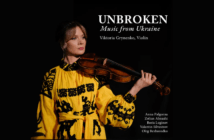The Toronto Symphony Orchestra’s May 10th concert featured two stalwarts of the Classical canon: Brahms’ grand Violin Concerto in D Major with German violinist Frank Peter Zimmermann, and Tchaikovsky’s searing Symphony No. 4. Added ingredients came in the form of a short new work by Canadian composer Julia Mermelstein and the young musicians of the Toronto Symphony Youth Orchestra (TSYO) who joined the TSO for the Tchaikovsy.
What you missed
A world premiere, Mermelstein’s Ray trace is inspired by Twilight, a painting by American artist Norman Lewis. As the composer mentions in the program, Lewis’s piece explores “forms of vibrant colour strokes against dark tones and lines, blurring together, and yet distinct.”

Norman Lewis, Twilight, 1956
Ray trace hails from the same abstract, colouristic tradition, offering great washes of string tone, eschewing melody in favour of big blocks of sound. Occasionally, sparks of brighter colour from the xylophone and brass emerged from the overall texture. The piece sparked curiosity as to how Memelstein might expand on this painterly approach in a longer work.
Zimmerman took a subtle approach to the Brahms concerto that was in keeping with the work’s organic treatment of the solo violin as one element of many. TSO Music Director Gustavo Gimeno maintained a careful balance between soloist and orchestra in Roy Thomson Hall’s notoriously dry acoustic, such that even Zimmerman’s sweetest effects in the first movement were not overwhelmed.
The pastoral interplay of woodwinds that open the second movement were a highlight, especially with principal oboe Sarah Jeffrey’s aching solo. The famous Hungarian dance rhythms of the final movement were pounced upon by Gimeno and his forces with admiral attack and stylish rallentandi that added authentic folk-like flavour.

German violinist Frank Peter Zimmermann, Photo by Allan Cabral
Zimmerman’s playing was polished throughout, always in control even in more technically challenging moments like the first movement’s virtuosic cadenza. After a warm ovation, the violinist returned for two encores. He captured the desperation, fear and ultimate horror in Ernst’s Grand Caprice based on the Schubert song, “Erlkönig”. Then, in complete contrast, ended with simple serenity in a Bach solo.
Gripes
In the second half, the stage was filled to capacity with members of the TSO playing alongside their youthful TSYO counterparts for the Tchaikovsky. This paid off in an extra-loud, prick-up-your-ears rendering of the opening “fate fanfare,” which returns as a motif throughout the first movement. Its contrasting waltz theme was taken very slowly by Gimeno, almost to the point of a loss of momentum. His intentions became a bit clearer as the tempi gradually sped up to launch each return of the blaring fate theme, but by then, some of the excitement seemed to have been lost.

Photo by Allan Cabral
Tchaikovsky created almost an entire scherzo movement from string pizzicati which, considering the number of musicians, was remarkably fleet and coherently structured with pointed emphases and dynamic variation. In the final fiery allegro movement, tempi felt quite pushed resulting in a slight loss of clarity in the strings especially. Gimeno ratcheted things up even more in the final bars to evince the now-standard Toronto standing-ovation.
The TSYO’s 50th Anniversary
In a short speech from the podium, Gimeno acknowledged the TSYO’s 50th anniversary as well as the success of the program in producing so many professional musicians who have eventually joined the ranks of the TSO as well as other major orchestras throughout the world. In an age of almost daily reports of cuts to classical music training at schools and universities, we can only be grateful to entities like the TSYO and wish them another 50 years of success.
For more information on the TSO: www.tso.ca/















